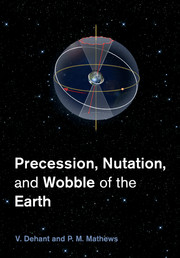Book contents
- Frontmatter
- Contents
- Preface
- List of abbreviations
- 1 Introduction – Fundamental definitions – Motivation
- 2 Concepts and elementary theory
- 3 Reference systems and frames
- 4 Observational techniques – ephemerides
- 5 Rigid Earth precession and nutation
- 6 Deformable Earth – Love numbers
- 7 Nutations of a non-rigid Earth
- 8 Anelasticity
- 9 Ocean and atmospheric corrections
- 10 Refinements of non-rigid nutation
- 11 Comparison observation-theory
- 12 Conventions
- 13 Mars nutations
- Appendix A Rotation representation
- Appendix B Clairaut theory
- Appendix C Definitions of equinoxes
- Bibliography
- Index
11 - Comparison observation-theory
Published online by Cambridge University Press: 05 May 2015
- Frontmatter
- Contents
- Preface
- List of abbreviations
- 1 Introduction – Fundamental definitions – Motivation
- 2 Concepts and elementary theory
- 3 Reference systems and frames
- 4 Observational techniques – ephemerides
- 5 Rigid Earth precession and nutation
- 6 Deformable Earth – Love numbers
- 7 Nutations of a non-rigid Earth
- 8 Anelasticity
- 9 Ocean and atmospheric corrections
- 10 Refinements of non-rigid nutation
- 11 Comparison observation-theory
- 12 Conventions
- 13 Mars nutations
- Appendix A Rotation representation
- Appendix B Clairaut theory
- Appendix C Definitions of equinoxes
- Bibliography
- Index
Summary
Empirical models for nutations (such as IERS96)
In order to be very close to the nutation observation, one possibility is to consider a model with a very simple form and of which the parameters can be fitted on the observation. In that case, ignoring the a-priori corrections that are explained in the next paragraph, the parameters cannot be interpreted in terms of the physics of the Earth's interior. This empirical model cannot be considered as a geophysical model.
Estimation of basic Earth parameters from VLBI
We have seen in Chapter 5 that the rigid Earth nutations are quite well determined, with the exception of a scaling factor for the global Earth flattening. The precession and low frequency nutations due to the action of the degree two tesseral gravitational potential of the solar system bodies at the first order in the potential may be calculated to high accuracy as shown in that chapter.
Other contributions to Earth rotation with frequencies outside the low frequency band, in the celestial frame are produced by the other components of the potential. They have been computed in Chapter 10 and are outside of the scope of a fit to VLBI (Very Long Baseline Interferometry) data as they contribute to polar motions of the CIP and are not considered as nutations of the CIP. However, we must consider (1) the contributions of the order of 0.1 mas or smaller to a couple of low frequency nutations from the degree three tidal potential acting on J3, and about 25 µas/year to precession from the degree four potential acting on J4 (see Chapter 5). We must also consider (2) contributions of the second order in the perturbing potential, which arise from the action of each of the three parts (zonal, tesseral, and sectorial) of the potential on the increment to the density function that is produced by the tidal deformation induced by these three parts. They have been evaluated in Chapter 10 where it was shown that the effect on precession–nutation is practically nil because of mutual cancellations.
- Type
- Chapter
- Information
- Precession, Nutation and Wobble of the Earth , pp. 415 - 424Publisher: Cambridge University PressPrint publication year: 2015



